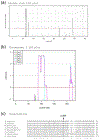A family study implicates GBE1 in the etiology of autism spectrum disorder
- PMID: 34633740
- PMCID: PMC8720068
- DOI: 10.1002/humu.24289
A family study implicates GBE1 in the etiology of autism spectrum disorder
Abstract
Autism spectrum disorders (ASD) are neurodevelopmental disorders with an estimated heritability of >60%. Family-based genetic studies of ASD have generally focused on multiple small kindreds, searching for de novo variants of major effect. We hypothesized that molecular genetic analysis of large multiplex families would enable the identification of variants of milder effects. We studied a large multigenerational family of European ancestry with multiple family members affected with ASD or the broader autism phenotype (BAP). We identified a rare heterozygous variant in the gene encoding 1,4-ɑ-glucan branching enzyme 1 (GBE1) that was present in seven of seven individuals with ASD, nine of ten individuals with the BAP, and none of four tested unaffected individuals. We genotyped a community-acquired cohort of 389 individuals with ASD and identified three additional probands. Cascade analysis demonstrated that the variant was present in 11 of 13 individuals with familial ASD/BAP and neither of the two tested unaffected individuals in these three families, also of European ancestry. The variant was not enriched in the combined UK10K ASD cohorts of European ancestry but heterozygous GBE1 deletion was overrepresented in large ASD cohorts, collectively suggesting an association between GBE1 and ASD.
Keywords: autism spectrum disorder; broader autism phenotype; genetics; glycogen branching enzyme; linkage; whole exome sequencing.
© 2021 Wiley Periodicals LLC.
Conflict of interest statement
Figures





References
Publication types
MeSH terms
Substances
Grants and funding
LinkOut - more resources
Full Text Sources
Medical
Molecular Biology Databases

